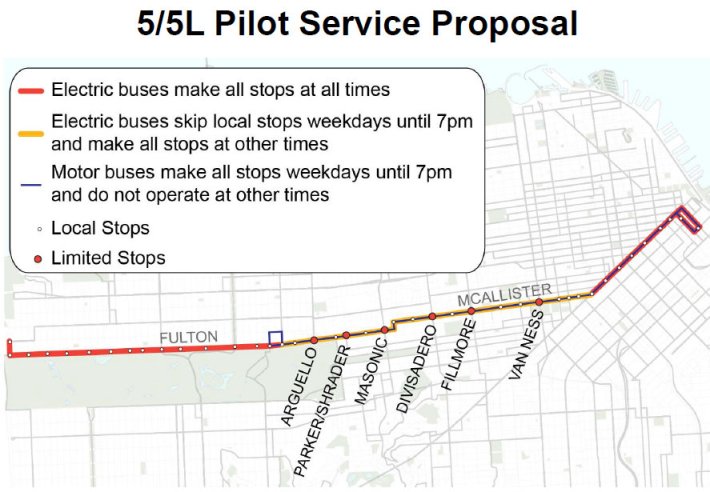The 5-Fulton could get less crowded this fall after Muni launches a package of speed improvements [PDF] in a pilot of the Transit Effectiveness Project.
The SFMTA plans to launch a 5-Fulton Limited line, remove some excess stops, move stops across intersections for smoother loading, and extend the length of bus zones to make room for double bus loading. Early next year, planners said bus bulb-outs would be also be added at seven intersections as part of a re-paving project on Fulton west of 25th Avenue.
A road diet would also be implemented on Fulton between Stanyan Street and Central Avenue, reducing four traffic lanes to two, plus turn lanes. Aside from calming traffic, SFMTA planners said that change would allow for wider traffic lanes to safely fit buses. Currently, the buses must squeeze into 9-foot lanes, resulting in a high frequency of collisions with cars. The new lanes would be 12.5 feet wide.
The new 5-Limited would run the entire length of the route using the 5's regular electric trolley coaches, serving only the six most heavily-used stops between Market Street and 6th Avenue, running that stretch 17 percent faster than the existing local service, planners said. From the Transbay Terminal to the beach, the 5L would run 11 percent faster than the existing service.
Local bus service, which would be served with hybrid motor buses, would only run as far west as 6th Avenue, and run that stretch 7 percent faster. That means anyone looking to use a local stop on the middle stretch east of 6th, coming to or from the western stretch, would have to transfer between a 5L bus and a 5-local, though planners said relatively few riders seem to make such trips. The 5-Limited would stop running at 7 p.m., after which electric trolley coaches would serve every stop on the line.
With the 5L carrying the bulk of rush-hour commuters on the route at a faster clip, Muni planners say the improvements will go a long way toward reducing crowding. At daytime hours, between 6 a.m. to 6 p.m., the 5 currently runs at an average speed of just 9 mph, said SFMTA planner Dustin White.
"One of the reasons is that we make a lot of stops," White said at a community meeting yesterday. "It's a high-ridership route, and it's spread throughout the line, but there are a couple key points where [boardings are] concentrated -- in particular, between 6th Avenue and Van Ness."
Mario Tanev of the SF Transit Riders Union said the organization supports Muni's efforts to expedite some of the TEP improvements, and "showcase the potential benefits system-wide."
"Implementation of the TEP is long overdue," he said. "We hope that the Fulton corridor will soon be followed by other corridors in receiving these improvements."
The eight proposed stop removals (in each direction) would require only 9 percent of 5-Fulton riders to use a different stop, White said. On the Richmond stretch of the line, between La Playa Street and Arguello Boulevard, the average space between stops would be expanded from 2.3 blocks to 3 blocks, or 710 feet to 930 feet. Between Arguello and Market, where blocks are longer, average stop spacing would increase from 1.5 blocks to 2 blocks, or 730 feet to 960 feet.
As Streetsblog has reported, 70 percent of Muni stops are closer together than the agency's own guidelines dictate, and 61 percent of riders in a survey said they'd be willing to walk a bit further for a faster trip. Proposals to remove bus stops have often faced strong opposition from the riders who use them -- especially elderly and disabled riders, though at yesterday's meeting, only one man made such a complaint.
Howard Strassner, chair of the local Sierra Club chapter's transportation committee, urged the SFMTA to take out even more stops. "I think I'm old enough to have that right," he said, noting that riders on the 28 line do just fine using the stops along Park Presidio, which are 1,400 feet apart. "If you can do it on Park Presidio, you can do it on most of the city."
The most contentious issue raised by attendees at the meeting was the proposed removal of roughly 30 car parking spaces, mainly for the extension of 23 bus stop zones. Planners said that measure is necessary to keep the line running smoothly, as it would allow local and limited-stop buses to load at shared stops at the same time, and make it easier for local bus drivers to pull close enough to the curb to allow limited-stop buses to pass them.
"Right now, it's sort of a cat-and-mouse game on Mission Street between the limiteds and locals," said SFMTA Outreach Manager Lulu Feliciano, referring to Mission's 14 and 14-Limited lines, which must often squeeze into cramped bus zones. "We want them to play nicer this time."
At intersections with traffic signals, any bus stops currently on the near-side of intersections would be moved to the far side to allow buses to clear the signal before loading and pull up to the curb more easily. At intersections with stops signs, far-side stops would be moved near-side instead, so that buses don't need to stop twice.
Right-turn lanes would also be added at five intersections to prevent right-turning drivers from holding up buses, White said. Planners are also looking to reduce blockages from semi trucks loading at a Lucky supermarket dock on Central, possibly by removing curbside parking to make room or cracking down on truck drivers. That parking removal proposal roused up opposition form several attendees at the meeting.
In a few years, the SFMTA plans to add more permanent TEP improvements to the 5, including more bus bulb-outs and overhead wires that would allow electric trolleys to run on the new local service line.
The 5-Limited is expected to launch in October.







